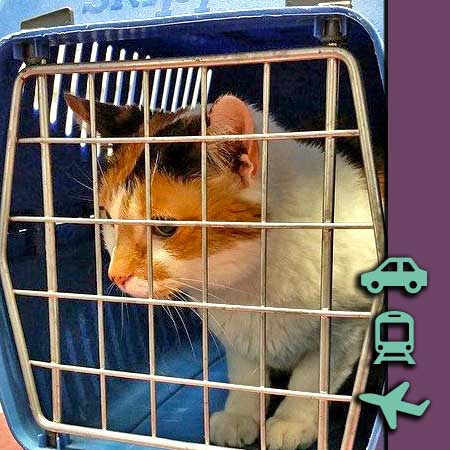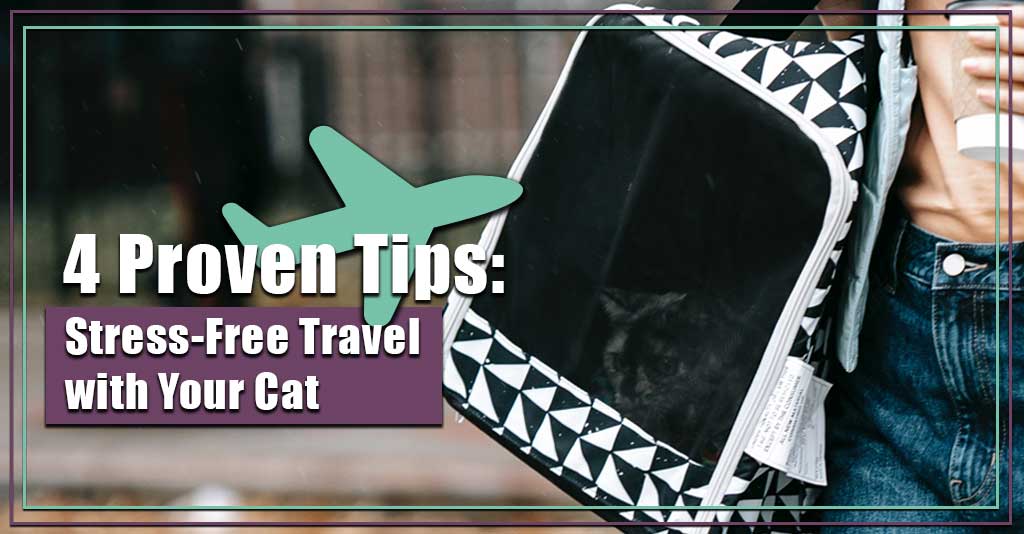Let’s just get right down to it: travel with your cat can be stressful.
Cats are extremely territorial animals, so any change in their environment can feel overwhelming and threatening. This includes changing/moving homes, change in people or animals within their environment, switching or moving furniture, and you guessed it, travel.
The thing is, travel with your cat is sometimes an unavoidable part of life. If your cat is experiencing a medical emergency, you are moving across the country, or there is a threatening situation in your home or town, putting your cat into a car or plane is non-negotiable. In this article, I will break down essential tips and steps to start right away, in order to keep traveling and transportation minimally stressful for both you and your kitty.
Be prepared.
Your cat should always be in a carrier whether traveling in a car or plane, and it is therefore crucial that you have at least one traveling carrier per cat in your home. I prefer soft carriers that have multiple entrances from the top, front, or side of the carrier. Be sure your carrier securely closes and that the handles used to carry it are durable.
Avoid any DIY carrier like a temporary cardboard carrier, laundry basket, or tote bag. These can easily break, causing injury or causing your cat to flee. Never put more than one kitty in a single carrier to avoid fights! Good carriers are a place for your cat to feel safe, comfortable and secure during travel! My favorite carrier is here.
When you travel with your cat, label your carrier with your name and contact information, as well as your cat’s name and information. Make sure your cat has a break-away collar with updated tags on during any trip, as an extra means of identification.
Desensitize your cat to their crate.

A key component of travel with your cat is the crate or travel carrier. The truth is, most of us don’t pull our cat’s travel carrier out until we need to use it. Since cats are territorial, this “strange device” can feel extremely off-putting to them!
If possible, place your travel carrier somewhere within your home that your cat will have constant access to. Place soft bedding or blankets inside to make it more comfortable and inviting. Add your cat’s favorite toy, catnip, treats or meals in the carrier or cover it with a towel to make a DIY covered bed.
When your cat is comfortably inside, try closing it for just a few moments before opening it again. Work up to closing the carrier and walking around the house, sitting in the car, or even driving around the block. All of these various interactions for your cat create a positive association for them to the carrier, ideally making it easier to safely put your cat into the carrier for transport when the time comes.
Medications and supplements.

Travel with your cat isn’t just stressful for you – your kitty feels it too. Having supplements or medications for extra-anxious cats is never wrong!
Our favorite go-to supplement to help reduce fear and anxiety for kitties who are traveling is CBD, and our preferred product is the HempRx Feline Drops. Dr. Angie’s dosing chart is available here, however there is a lot of wiggle room for dosing, and room to work up. If you need a more tailored protocol for your cat, consider signing up for a CBD phone consultation with me!
Sometimes, pharmaceuticals are needed, and that’s ok! Work closely with your veterinarian on a medication protocol for your kitty. If possible, give yourself a lot of time and try a test round of the medication with a short trip around your neighborhood before the “real deal”. This will give you and your vet an idea of how your cat will respond to the medication, and if any changes are needed for optimal results.
Consider the distance.
Depending on how far you’re going to travel with your cat there are many aspects you may consider.
If you are traveling for more than 4 hours in the car, you may want to have a larger/hard crate for your cat in order to ensure they have food, water, litter and a small litter box available to them. If possible, check in on your kitty every couple of hours to ensure their crate is clean. Have replacement bedding, toys, bowls, and nonabsorbable potty pads available in case there’s an accident or mess made. Cover the top of the carrier or crate with a blanket to avoid extra and potentially anxiety-inducing stimuli.
If your cat is traveling via plane, make sure you know specific requirements from the airline you are flying. If a health certificate is required, work with your veterinarian to ensure you are meeting those requirements and deadlines as well. Oftentime, health certificates for flying must be completed within a certain amount of days before the flight, and may require proof of vaccinations. Understanding the process well in advance will keep you from scrambling and stressing last minute!
International health certificates are almost always more comprehensive than domestic. Your veterinarian will charge a fee to make sure all of this paperwork is properly completed for you before take off! If at all possible, make sure your cat is traveling in the cabin with you as opposed to in cargo. This is a much safer and more prefered option for you kitty!
If you’re stressed about needing to travel with your cat, you’re so not alone! The truth is, many cats don’t even make it into their veterinarian’s clinic for care because of this single stressor alone. But avoiding the situation is ultimately not in you or your kitty’s best interest, and there are a lot of ways to make this experience easier for you both!
I hope this article has helped you learn helpful tips for travel with your cat! Let me know in a comment below!
Love,
Claire



I have found that Squeaky does better when he is sedated a bit. Also every 1-1/2 hours, he needs a break. I stop the car, let him out of his crate so he can roam in the car a bit, and cuddle, pet and love him. Then he goes right back into his crate and we continue on our way!
Hi Jan,
Such great suggestions!
Warmly,
Claire